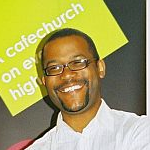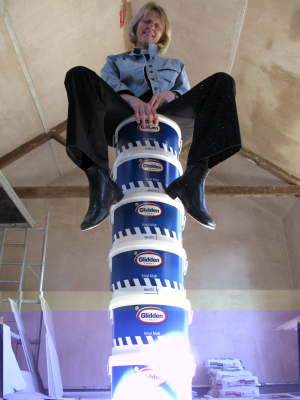This story illustrates the principles of What form should our fresh expression take? in the Guide.
New Creations is a craft group begun in 1998 that developed into a church cell attended by over 40 women in a Merseyside parish.
Getting together
Getting together to explore an idea was the starting point. Lay reader and bereavement co-ordinator, Janet Cross, found that one widow she was visiting had taken up crafts. A keen card maker herself, Janet 'could see that it was helping her' so she took the idea of a craft group as 'occupational therapy' for the bereaved to her vicar.
She also approached two friends: a fellow member of the bereavement team and the widow whose hobby had inspired the idea. She asked them both to meet with her to pray for the new group every now and then and to help her run it.
Exploring the possibilities
Exploring the possibilities occurred on a try-and-see basis. An invitation was given out through the parish for anyone interested to join in a crafts meeting every Tuesday afternoon. Tables were set up in the body of the church. An opening prayer was followed by a demonstration and the opportunity to practise.
As New Creations developed, the group discovered that members enjoyed making cards and this has been the focus of the craft session ever since.
Janet got to know the group and could sense what would work. In time, the opening prayer developed into a monthly ten-minute 'God slot', a short talk centred around the theme of the cards to be made that session.
A while later, Janet asked the members individually whether they would like to come to a support and prayer meeting for half an hour before lunch. A few said they would.
Those who were unchurched (around twelve) began attending one meeting, while the churched (around seven) attended another at the same time, forming two new 'clusters' meeting for discussion and prayer.
These sessions grew into hour-long meetings and eventually merged as the unchurched grew in faith, making one large cluster ready to divide again. Over 40 members are now registered with New Creations, with 16 of them attending the cluster.
Thinking ahead
Thinking ahead in the way that we have described the process doesn't seem to have been part of the story. However, Janet was in a church with a strong tradition of cells and clusters, and it would be surprising if this did not influence her expectations for the group.
Might New Creations help you as you 'think ahead'? You probably won't want to do exactly what Janet did, but does the example of a short prayer evolving into a 'God slot', which then develops into two clusters, spark some thoughts? Might it help you develop a vision for how your fresh expression could develop?
Organising support
Organising support is illustrated in the way Janet has continued to meet with her vicar – the key permission giver – to discuss New Creations. The question, 'How's it going?' is a chance to talk things through and find support. It also means that the work of New Creations is plugged into the life of the church.
Support from people within the group is evident from their financial contributions. Members pay £1 a week subscription to the group, which covers expenses such as heating, cake on birthdays and flowers when a member is sick. They also pay a second £1 for the craft kits.
Janet tries 'to get all involved'. For example, one member provides a cake on birthdays, another arranges flowers when a member is sick, another is good at encouraging members to demonstrate their skills. Several members now take turns at leading the demonstration.
One person, whom Janet describes as 'a listener' and 'very quiet', is the first to call up a fellow member if she is absent one week. She also gives cards and candles to every member at Christmas. Her faith is coming out through her actions, Janet believes.
Nurturing the team
Nurturing the team has taken a while to become a strong feature of New Creations. However, after nearly 10 years Janet is moving on and away from Merseyside. With this in mind, she is inviting the nine helpers within the group to form three teams of three.
Members of New Creations sit at three tables. Each week one helper will lead and assist at their table, and provide a demonstration. So each person in the team will be on duty once every three weeks, sharing the load and helping to avoid burn-out.
The response
When members were asked what New Creations meant to them, the response was overwhelmingly positive. One member spoke of rediscovering a lost childhood faith. 'I realise now what I've missed,' she says.
From an idea conceived by one woman who identified a shared interest and need, several women now participate in supporting a group which offers fellowship and discipleship within the wider support of a church community.


 Cid Latty asks whether there's an alternative to closing churches.
Cid Latty asks whether there's an alternative to closing churches.
 It is almost three years since Burning Bush Barn was established as a place of creativity and contemplation. Wendy Shaw has seen how the quiet space has become a place of blessing for many.
It is almost three years since Burning Bush Barn was established as a place of creativity and contemplation. Wendy Shaw has seen how the quiet space has become a place of blessing for many. When my husband became Rector at Rockland St Mary, the barn was derelict in the garden but we could see how the building could be used in a new way for our developing needs. The fundraising appeal for £203,000 was launched in May 2007 to renovate and preserve it. Much has been done because we now have a worship/gallery space and studio space but there's more to do because we'd love to have a hospitality space too. We have got planning permission to do that but have still got to raise about £65,000 to pay for it.
When my husband became Rector at Rockland St Mary, the barn was derelict in the garden but we could see how the building could be used in a new way for our developing needs. The fundraising appeal for £203,000 was launched in May 2007 to renovate and preserve it. Much has been done because we now have a worship/gallery space and studio space but there's more to do because we'd love to have a hospitality space too. We have got planning permission to do that but have still got to raise about £65,000 to pay for it. We often say we don't know where we're going here but the important thing is to watch and wait for the move of the wave. As a result we don't know how long to be on that wave but that's OK. I may want to know what I'm doing this time next year but I can't tell you that. We have to wait.
We often say we don't know where we're going here but the important thing is to watch and wait for the move of the wave. As a result we don't know how long to be on that wave but that's OK. I may want to know what I'm doing this time next year but I can't tell you that. We have to wait.


 The Sidewalk community who facilitate this ministry meet weekly for food and fun. They meet in the park to continue to build relationships with families there and then gather in a team member's home. In terms of the fresh expressions journey, they are now preparing for the stage of what kind of worship will sustain them. What kind of deeper spiritual disciplines or input is appropriate for the community that is made up of seasoned Christians, new Christians and not yet Christians that all play a part in making Sidewalk happen?
The Sidewalk community who facilitate this ministry meet weekly for food and fun. They meet in the park to continue to build relationships with families there and then gather in a team member's home. In terms of the fresh expressions journey, they are now preparing for the stage of what kind of worship will sustain them. What kind of deeper spiritual disciplines or input is appropriate for the community that is made up of seasoned Christians, new Christians and not yet Christians that all play a part in making Sidewalk happen?